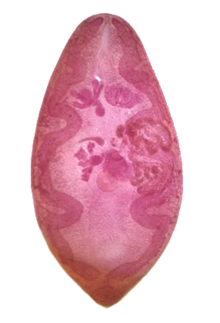Paragonimiasis is a food-borne parasitic infection caused by the lung fluke, most commonly Paragonimus westermani. It infects an estimated 22 million people yearly worldwide. It is particularly common in East Asia. More than 30 species of trematodes (flukes) of the genus Paragonimus have been reported; among the more than 10 species reported to infect humans, the most common is P. westermani, the oriental lung fluke.
Life cycle

The U.S. Centers for Disease Control and Prevention (CDC) has a detailed description and an explanatory image of the Paragonimus lifecycle: [1]
- "The eggs of the paragonimiasis are excreted unembryonated in the sputum, or alternately they are swallowed and passed with stool. In the external environment, the eggs become embryonated, and miracidia hatch and seek the first intermediate host, a snail, and penetrate its soft tissues. Miracidia go through several developmental stages inside the snail: sporocysts and rediae, with the latter giving rise to many cercariae, which emerge from the snail. The cercariae invade the second intermediate host, a crustacean such as a crab or crayfish, where they encyst and become metacercariae. This is the infective stage for the mammalian host. Human infection with P. westermani occurs by eating inadequately cooked or pickled crab or crayfish that harbor metacercariae of the parasite. The metacercariae excyst in the duodenum, penetrate through the intestinal wall into the peritoneal cavity, then through the abdominal wall and diaphragm into the lungs, where they become encapsulated and develop into adults (7.5 to 12 mm by 4 to 6 mm). The worms can also reach other organs and tissues, such as the brain and striated muscles, respectively. However, when this takes place completion of the life cycles is not achieved, because the eggs laid cannot exit these sites. Time from infection to oviposition is 65 to 90 days. Infections may persist for 20 years in humans. Animals such as pigs, dogs, and a variety of feline species can also harbor P. westermani."
Geographic distribution

Species of Paragonimus are widely distributed in Asia, Africa, and North and South America. Paragonimus westermani is found in southeast Asia and Japan, while Paragonimus kellicotti is endemic to North America.
Symptoms and diagnosis

- "The acute phase (invasion and migration) may be marked by diarrhea, abdominal pain, fever, cough, urticaria, hepatosplenomegaly, pulmonary abnormalities, and eosinophilia. During the chronic phase, pulmonary manifestations include cough, expectoration of discolored sputum, hemoptysis, and chest radiographic abnormalities. Extrapulmonary locations of the adult worms result in more severe manifestations, especially when the brain is involved." "Diagnosis is based on microscopic demonstration of eggs in stool or sputum, but these are not present until 2 to 3 months after infection. (Eggs are also occasionally encountered in effusion fluid or biopsy material.) Concentration techniques may be necessary in patients with light infections. Biopsy may allow diagnostic confirmation and species identification when an adult or developing fluke is recovered."
Paragonimiasis can commonly be misdiagnosed as tuberculosis.
Treatment
The drug of choice to treat paragonimiasis is praziquantel, although bithionol may also be used.
See also
- Drunken shrimp




0 komentar :
Posting Komentar